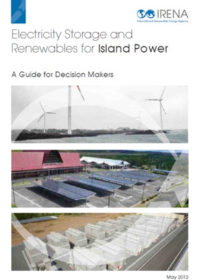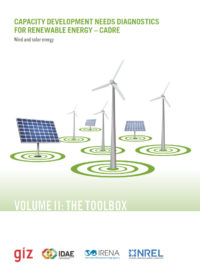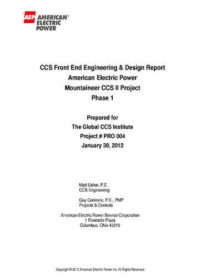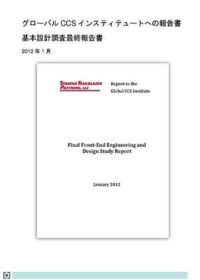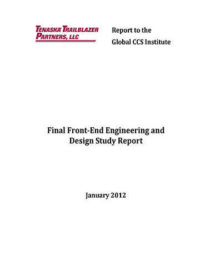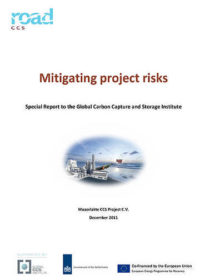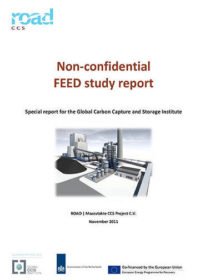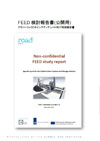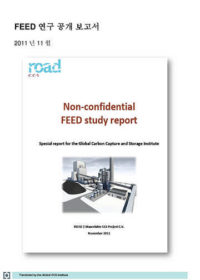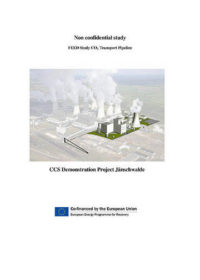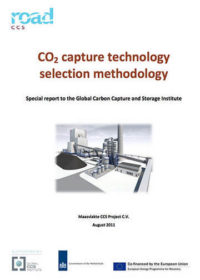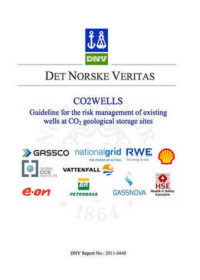Resources
Publications
Our publications, reports and research library hosts over 500 specialist reports and research papers on all topics associated with CCS.
View our Publication Library Disclaimer.
Filter by
Electricity storage and renewables for island power: a guide for decision makers
1st May 2012
Topic(s): Engineering and project delivery, Renewables
The International Renewable Energy Agency has developed this report as a practical guide to the available energy storage solutions and their successful applications in the context of islands communities. The report also includes various best practice cases and different scenarios and strategies.
Disclaimer
The content within the Global CCS Institute Publications, Reports and Research Library is provided for information purposes only. We make every effort and take reasonable care to keep the content of this section up-to-date and error-free. However, we make no claim as to its accuracy, currency or reliability.
Content and material featured within this section of our website includes reports and research published by third parties. The content and material may include opinions and recommendations of third parties that do not reflect those held by the Global CCS Institute.
Capacity development needs diagnostics for renewable energy: wind and solar energy. Volume II: the toolbox
1st April 2012
Topic(s): Capacity development, Engineering and project delivery, Renewables
Capacity building measures need to be based on a capacity development strategy and implementation plans that ensure the balanced and sustainable growth of the national and local renewable energy sector.
The Capacity Development Needs Diagnostics for Renewable Energy (CaDRE) helps policy makers, organisations and capacity development/renewable energy practitioners shape an environment conducive to the development of renewable energy. CaDRE is designed as a country-driven, comprehensive approach to analysing the capacity already in place, predicting future capacity needs, identifying capacity gaps and providing recommendations for creating capacity development strategies. It is based on the guiding principle that no successful capacity development strategy can be built without intensive stakeholder engagement.
This Handbook and Toolbox provide modular guidelines and practical tools for planning and completing a comprehensive diagnostic of the energy landscape. They also supply the tools for conducting an analysis of capacity gaps related to solar and wind energy targets.
Disclaimer
The content within the Global CCS Institute Publications, Reports and Research Library is provided for information purposes only. We make every effort and take reasonable care to keep the content of this section up-to-date and error-free. However, we make no claim as to its accuracy, currency or reliability.
Content and material featured within this section of our website includes reports and research published by third parties. The content and material may include opinions and recommendations of third parties that do not reflect those held by the Global CCS Institute.
CCS front end engineering & design report: American Electric Power Mountaineer CCS II Project. Phase 1
30th January 2012
Topic(s): Carbon capture use and storage (CCUS), Engineering and project delivery
This public design report provides select non-proprietary design information from the Phase I – Project Definition work products associated with the carbon capture and storage (CCS) system planned for installation at Appalachian Power Company’s Mountaineer Plant, located in New Haven, West Virginia, under US Department of Energy (DOE) Cooperative Agreement No. DE-FE002673.
The overall objective of the project is to design, build and operate a commercial-scale CCS system capable of treating a nominal 235 MWe slip stream of flue gas from the outlet duct of the Flue Gas Desulfurization system. The project was planned for execution in four phases: Phase I - Project Definition (February 2010 – September 2011), Phase II - Design and Permitting (October 2011 – December 2012), Phase III – Construction and Start-up (January 2013 – August 2015), and Phase IV – Operations (September 2015 – June 2019). AEP and its integrated project team successfully completed Phase I objectives, as outlined in the cooperative agreement, calling for:
- the resolution of outstanding conditions with the DOE cooperative agreement;
- project specific developmental activities (front end engineering and design (FEED));
- the initiation of the NEPA process; and
- the identification of exceptionally long lead time items.
The FEED package incorporated knowledge gained and lessons learnt (construction and operations related) from the Mountaineer Product Validation Facility and the design package also established the fit, form, and function of the project including design criteria, mass and energy balances, plot plans, general arrangement drawings, electrical one-lines, flow diagrams and P&IDs.
Based on the work completed in the FEED package, the project team also:
- developed a +/- 25 per cent cost estimate;
- developed a detailed Phase II project schedule;
- provided DOE with all information it needed to complete the NEPA process;
- developed a multi prime construction contracting strategy for Phase III;
- issued preliminary PFDs and overall mass and energy balances;
- drilled a deep well for characterisation of subsurface geology at one of the alternative CO2 storage sites;
- completed preliminary project design; and
- submitted a decision point application regarding future project plans.
Disclaimer
The content within the Global CCS Institute Publications, Reports and Research Library is provided for information purposes only. We make every effort and take reasonable care to keep the content of this section up-to-date and error-free. However, we make no claim as to its accuracy, currency or reliability.
Content and material featured within this section of our website includes reports and research published by third parties. The content and material may include opinions and recommendations of third parties that do not reflect those held by the Global CCS Institute.
基本設計調査最終報告書
1st January 2012
Topic(s): Carbon capture use and storage (CCUS), Engineering and project delivery
Trailblazerは、米国テキサス州Nolan郡Sweetwaterの東約9マイルに位置する、建設中の超臨界微粉炭火力(PC: Pulverized coal)発電所である。Trailblazerは、初期設計に商用規模の燃焼後回収式CO2回収(CC: Carbon dioxide capture)プラントを取り入れて建設される米国初の石炭火力発電所となる見込みである。本プロジェクトは本来なら大気中に排出されるはずのCO2の85~90%を回収する設計となっている。本発電所は総出力760MW(夏季のCCプラント稼働時の環境温度下)を発電する計画である。
本プロジェクトの目的は、来るべき炭素規制に関連した潜在的な先行的クレジットの活用、回収したCO2のPermian Basinにおける石油増進回収(EOR: Enhanced oil recovery)への有効利用及び石炭利用と国内石油生産を通じた米国のエネルギー安全保障への貢献である。
プロジェクトの開発推進に当たり、Tenaska社は、プロジェクトの設計・調達・建設(EPC: Engineering, construction and procurement)業者及びCC技術提供者の選定のため、それぞれの競争入札手続きを実施した。これらの過程を経て、Tenaska社は、Econamin FG+(EFG+) CO2回収技術の提供を含むEPC業者及び技術提供者双方の役割を担う業者にFluor Enterprises社を選定した。
Tenaska社は、CCプラントに関する基本設計(FEED: Front-end engineering and design)調査を実施するためFluor社と契約した。開発途上のこの産業においては、サプライヤーに大規模な商用CCプラントに関する経験がないことから、FEED調査が不可欠である。FEED調査の主な目的は、提示された確定価格及び商用稼動時の性能保証を裏付けるため、プロジェクトについての十分な技術的な定義(設計及び計画作業に係る労力全体の名目上15~20%を必要とする)を行うことである。
Disclaimer
The content within the Global CCS Institute Publications, Reports and Research Library is provided for information purposes only. We make every effort and take reasonable care to keep the content of this section up-to-date and error-free. However, we make no claim as to its accuracy, currency or reliability.
Content and material featured within this section of our website includes reports and research published by third parties. The content and material may include opinions and recommendations of third parties that do not reflect those held by the Global CCS Institute.
Final front-end engineering design (FEED) study report
1st January 2012
Topic(s): Carbon capture use and storage (CCUS), Engineering and project delivery
Disclaimer
The content within the Global CCS Institute Publications, Reports and Research Library is provided for information purposes only. We make every effort and take reasonable care to keep the content of this section up-to-date and error-free. However, we make no claim as to its accuracy, currency or reliability.
Content and material featured within this section of our website includes reports and research published by third parties. The content and material may include opinions and recommendations of third parties that do not reflect those held by the Global CCS Institute.
Mitigating project risks: special report to the Global Carbon Capture and Storage Institute
7th December 2011
Topic(s): Carbon capture use and storage (CCUS), Engineering and project delivery
ROAD stands for ‘Rotterdam Opslag en Afvang Demonstratieproject’ (Rotterdam Capture and Storage Demonstration Project) and is one of the largest integrated demonstration projects in the world for the capture and storage of CO2, based on a new coal-fired power station located outside of Rotterdam, the Netherlands.
The ROAD project has received support from the Institute to contribute to the international development of knowledge, experience and information on CCS. Ultimately, the development of hands-on CCS knowledge and expertise should accelerate the commercial deployment of CCS projects worldwide.
In this report, which is part of a series of reports from the ROAD project, the risk management methodology developed by the ROAD project team is described and evaluated, including the description of the main project risks, mitigating actions and residual risks. This is done with the aim of helping similar projects to identify and treat their own project risks
Disclaimer
The content within the Global CCS Institute Publications, Reports and Research Library is provided for information purposes only. We make every effort and take reasonable care to keep the content of this section up-to-date and error-free. However, we make no claim as to its accuracy, currency or reliability.
Content and material featured within this section of our website includes reports and research published by third parties. The content and material may include opinions and recommendations of third parties that do not reflect those held by the Global CCS Institute.
ROAD CCS non-confidential FEED study report: special report for the Global Carbon Capture and Storage Institute
29th November 2011
Topic(s): Carbon capture use and storage (CCUS), Engineering and project delivery
ROAD stands for ‘Rotterdam Opslag en Afvang Demonstratieproject’ (Rotterdam Capture and Storage Demonstration Project) and is one of the largest integrated demonstration projects in the world for the capture and storage of CO2, based on a new coal-fired power station located outside of Rotterdam, the Netherlands.
ROAD recently completed its front end engineering and design (FEED) studies and cost estimations for the project and has prepared a special report for the Global CCS Institute summarising the main results of the FEED study for the capture plant as performed by Fluor. This report includes topics such as technology selection, process flow diagrams, heat and mass balances, layout designs, cooling studies, capital and O&M cost estimates and project schedules.
The report aims to help other CCS projects, particularly those using post-combustion capture technology, to design and cost their own capture plant. The report is also likely to be useful to regulatory, permitting and other stakeholders who want to gain an understanding of what considerations project proponents give to the range of decision factors, including environmental performance of technologies.
Disclaimer
The content within the Global CCS Institute Publications, Reports and Research Library is provided for information purposes only. We make every effort and take reasonable care to keep the content of this section up-to-date and error-free. However, we make no claim as to its accuracy, currency or reliability.
Content and material featured within this section of our website includes reports and research published by third parties. The content and material may include opinions and recommendations of third parties that do not reflect those held by the Global CCS Institute.
FEED 検討報告書(公開用) グローバルCCSインスティテュート向け特別報告書
29th November 2011
Topic(s): Carbon capture use and storage (CCUS), Engineering and project delivery
2009 年7 月、Maasvlakte CCS Project C.V.(「MCP」)は、欧州委員会にプロジェクト提案書を提出した。これが、「ROAD プロジェクト」(「Rotterdam Opslag en AfvangDemonstratieproject」:ロッテルダム貯留回収実証プロジェクト)の始まりである。欧州の資金援助を申請することにより、MCP は資金援助プログラムの要件(主にプロジェクトの工程に関するもの)を満たすことを約束した。プロジェクチームは、他の重要な境界条件にも配慮しつつ、特定の時間内で回収技術の供給業者を選ばなければならなかった。この理由により、プロジェクトチームは独自の選定方法論を開発した。
選定では、回収技術に関する2件のFEED(Front End Engineering Design)を同時並行で実施した。本報告書で記述するFEED は、受注に成功した供給業者によるものである。設計の一部は供給業者の機密情報であるため、設計の詳細をすべて開示することはできない。しかしながら、本文書の情報は、ROAD プロジェクトの将来の回収プラントの設計を的確に思い描くには十分である。
Disclaimer
The content within the Global CCS Institute Publications, Reports and Research Library is provided for information purposes only. We make every effort and take reasonable care to keep the content of this section up-to-date and error-free. However, we make no claim as to its accuracy, currency or reliability.
Content and material featured within this section of our website includes reports and research published by third parties. The content and material may include opinions and recommendations of third parties that do not reflect those held by the Global CCS Institute.
FEED 연구 공개 보고서
1st November 2011
Topic(s): Carbon capture use and storage (CCUS), Engineering and project delivery
Disclaimer
The content within the Global CCS Institute Publications, Reports and Research Library is provided for information purposes only. We make every effort and take reasonable care to keep the content of this section up-to-date and error-free. However, we make no claim as to its accuracy, currency or reliability.
Content and material featured within this section of our website includes reports and research published by third parties. The content and material may include opinions and recommendations of third parties that do not reflect those held by the Global CCS Institute.
FEED study CO2 transport pipeline: CCS Demonstration Project Jänschwalde. Non confidential study.
30th September 2011
Topic(s): Carbon capture use and storage (CCUS), CO2 transport, Engineering and project delivery
Disclaimer
The content within the Global CCS Institute Publications, Reports and Research Library is provided for information purposes only. We make every effort and take reasonable care to keep the content of this section up-to-date and error-free. However, we make no claim as to its accuracy, currency or reliability.
Content and material featured within this section of our website includes reports and research published by third parties. The content and material may include opinions and recommendations of third parties that do not reflect those held by the Global CCS Institute.
CO2 capture technology selection methodology
23rd September 2011
Topic(s): Carbon capture use and storage (CCUS), CO2 capture, Engineering and project delivery
ROAD stands for ‘Rotterdam Opslag en Afvang Demonstratieproject’ (Rotterdam Capture and Storage Demonstration Project) and is one of the largest integrated demonstration projects in the world for the capture and storage of CO2.
In this report, the selection methodology developed by the ROAD project team is described and evaluated, starting with the request for proposal for preliminary studies and ending with the final selection of the capture plant supplier. This report aims to help other CCS projects using post-combustion capture technology to design their own capture plant supplier selection methodology. In a broader sense, it is envisioned that other CCS projects or projects involving novel technologies can learn from the analysis provided in this report.
With respect to the capture supplier selection approach, the most prominent requirement introduced by this funding program was adherence to the challenging project schedule. As the development and construction of the capture plant are on the critical path of the project schedule, the project team had to find a way to select a capture plant supplier within the given time constraints, while still respecting other important constraints, such as cost, technical performance and health, safety and environment (‘HSE’) performance. For this reason, the project team developed a tailor made CO2 capture technology selection methodology.
This report is the first in a series of seven. Other knowledge sharing reports and case studies to be released in the coming months will cover a wide range of topics including: permitting, stakeholder consultation, commercial and funding arrangements, as well as the FEED study for the capture facility for the ROAD project.
Disclaimer
The content within the Global CCS Institute Publications, Reports and Research Library is provided for information purposes only. We make every effort and take reasonable care to keep the content of this section up-to-date and error-free. However, we make no claim as to its accuracy, currency or reliability.
Content and material featured within this section of our website includes reports and research published by third parties. The content and material may include opinions and recommendations of third parties that do not reflect those held by the Global CCS Institute.
CO2Wells: guideline for the risk management of existing wells at CO2 geological storage sites
27th June 2011
Topic(s): CO2 storage, Engineering and project delivery
Carbon Capture and Storage (CCS) technology offers the potential to reduce greenhouse gas emissions from industrial sources by permanently storing (sequestering) carbon dioxide in deep geological formations. This Det Norske Veritas guideline describes a work process for managing the risks and opportunities associated with existing wells at CO2 storage sites.
This publication is the final deliverable from the CO2WELLS Joint Industry Project (JIP). The JIP addressed industry and regulatory concerns about the potential for CO2 leakage along abandoned wells, and additionally existing wells and well conversions.
The sponsors of the CO2WELLS JIP were: DNV, Shell Canada, Petrobras, Vattenfall, E.On New Build & Technology Ltd. and E.ON Gas Storage GmbH, RWE Dea AG, UK Health & Safety Executive, National Grid, Global CCS Institute, Gassnova SF and Gassco AS.
Disclaimer
The content within the Global CCS Institute Publications, Reports and Research Library is provided for information purposes only. We make every effort and take reasonable care to keep the content of this section up-to-date and error-free. However, we make no claim as to its accuracy, currency or reliability.
Content and material featured within this section of our website includes reports and research published by third parties. The content and material may include opinions and recommendations of third parties that do not reflect those held by the Global CCS Institute.
